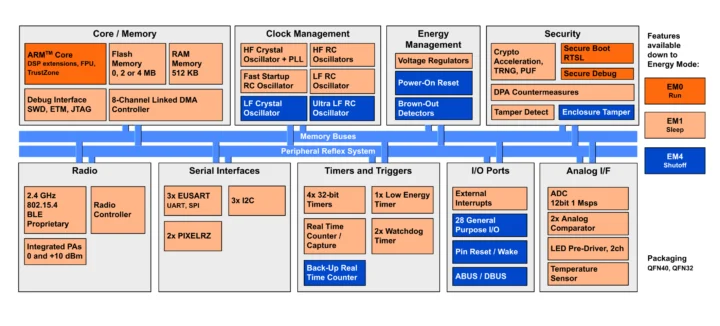Silicon Labs has just introduced the first 22nm Series 3 SoCs with the SiXG301 and SiXG302 Arm Cortex-M33 multiprotocol wireless SoCs designed for line-powered and battery-powered IoT devices, respectively.
The SiXG301 is offered with 4MB flash and 512 KB SRAM, embeds an LED pre-driver for advanced LED smart lighting and smart home products, and supports 2.4 GHz wireless protocols such as Bluetooth, Zigbee, and Thread with support for Matter. The upcoming SiXG302 Bluetooth and Matter SoC offers an ultra-low-power consumption using only 15 µA/MHz active current, or 30% lower than competitive devices in its class, and as such is ideal for battery-powered wireless sensors and actuators. We’ll be focusing on the SiMG301 multi-protocol SoC and SiBG301 Bluetooth LE SoC in this article since the details are sparse for the SiXG302 parts (SiMG302 and SiBG302).
Silicon Labs SiMG301 / SiBG301 specifications:
- MCU Core – 32-bit Arm Cortex-M33 with DSP instructions and floating-point unit clocked at 150 MHz
- Memory – 384KB or 512 kB RAM data memory
- Storage – Up to 4 MB co-packaged flash program memory or external QSPI memory interface with run-time authentication and encryption
- Wireless
- 2.4 GHz radio
- -106.3 dBm sensitivity @ 250 kbps O-QPSK DSSS
- -106.8 dBm sensitivity @ 125 kbps GFSK
- -98.6 dBm sensitivity @ 1 Mbps GFSK
- -95.7 dBm sensitivity @ 2 Mbps GFSK
- Tx power up to 10 dBm
- Modulation Formats
- 2 (G)FSK with fully configurable shaping
- OQPSK DSSS
- (G)MSK
- Protocols
- SiMG301
- Matter, OpenThread, Zigbee via 802.15.4 radio
- Bluetooth Low Energy, Bluetooth mesh, Proprietary 2.4 GHz
- Multiprotocol (DMP and CMP)
- SiBG301 – Bluetooth Low Energy, Bluetooth mesh, Proprietary 2.4 GHz
- SiMG301
- 2.4 GHz radio
- Peripherals
- Up to 28x GPIOs with output state retention and asynchronous interrupts
- 3 Enhanced Universal Synchronous/Asynchronous Receiver/Transmitter (EUSART) supporting UART/SPI/DALI/IrDA/SmartCard
3x I2C with SMBus support - 2-channel LED Pre-driver (LEDDRV)
- 2x Serial Pixel Interface (PIXELRZ)
- Analog
- 12-bit, 1 Msps ADC
- 2x Analog Comparator (ACMP)
- 8-channel DMA Controller (LDMA)
- 16-channel Peripheral Reflex System (PRS)
- Timers
- 2x 7-channel, 32-bit Timer/Counter with Compare, Capture, and Enhanced PWM capabilities
- 2x 3-channel, 32-bit Timer/Counter with Compare, Capture, and Enhanced PWM capabilities
- 2x 32-bit Real Time Counter (SYSRTC/BURTC)
- 24-bit Low-Energy Timer for waveform generation (LETIMER)
- 16-bit Pulse Counter with asynchronous operation (PCNT)
- 2x Watchdog Timer (WDOG)
- Die temperature sensor with unknown accuracy for now…
- Oscillators
- High-Frequency Crystal Oscillator (HFXO)
- High-Frequency RC Oscillator (HFRCO)
- Low-Frequency 32.768 kHz RC Oscillator (LFRCO)
- Low-Frequency 32.768 kHz Crystal Oscillator (LFXO)
- Security – Secure Vault High
- Hardware Cryptographic Acceleration for AES128/192/256, ChaCha20-Poly1305, SHA-1, SHA-2/256/384/512, ECDSA+ECDH(P-192, P-256, P-384), Ed25519 and Curve25519, J-PAKE, PBKDF2, SPAKE2+
- True Random Number Generator (TRNG)
- ARM TrustZone
- Secure Boot (Root of Trust Secure Loader)
- Secure Debug Unlock
- DPA Countermeasures
- Secure Key Management with PUF
- Anti-Tamper
- Secure Attestation
- DFA Detection
- Authenticated XiP (AXiP)
- Designed for PSA level 3 certification
- Power Consumption
- 8.1 mA RX current (1 Mbps GFSK EM1 @ 38.4 MHz)
- 9.0 mA RX current (250 kbps O-QPSK DSSS, EM1 @ 38.4 MHz)
- 11.4 mA TX current @ 0 dBm output power (EM1 @ 38.4 MHz)
- 28.6 mA TX current @ 10 dBm output power (EM1 @ 38.4 MHz)
- 47 μA/MHz in Active Mode EM0 at 150 MHz
- Supply Voltage – 1.8 V to 3.6 V single power supply
- Packages
- QFN32 4 × 4 mm
- QFN40 5 × 5 mm
- Temperature Range – -40 to 125°C
- Manufacturing process – 22nm

Silicon Labs explains that the Series 3 devices are the first wireless SoCs manufactured with a 22 nm process node to address the needs for “more powerful and efficient far-edge devices across a wide range of IoT applications”, which include smart cities, industrial automation, healthcare, smart homes, and so on.
Information about software development is limited, but we’re told the MCU and wireless tools, documentation, software, and source code libraries will be accessible through the usual Simplicity Studio IDE, available for Windows, macOS, and Linux. I could not find any information about development boards, although we can see some 3D renders in the video below.
Silicon Labs says the SiXG301 parts are already in production for select customers and slated for general availability in Q3 2025. The SiXG302 microcontrollers will take long, and sampling is planned for 2026. More details may be found on the product page and in the press release.

Jean-Luc started CNX Software in 2010 as a part-time endeavor, before quitting his job as a software engineering manager, and starting to write daily news, and reviews full time later in 2011.
Support CNX Software! Donate via cryptocurrencies, become a Patron on Patreon, or purchase goods on Amazon or Aliexpress. We also use affiliate links in articles to earn commissions if you make a purchase after clicking on those links.




